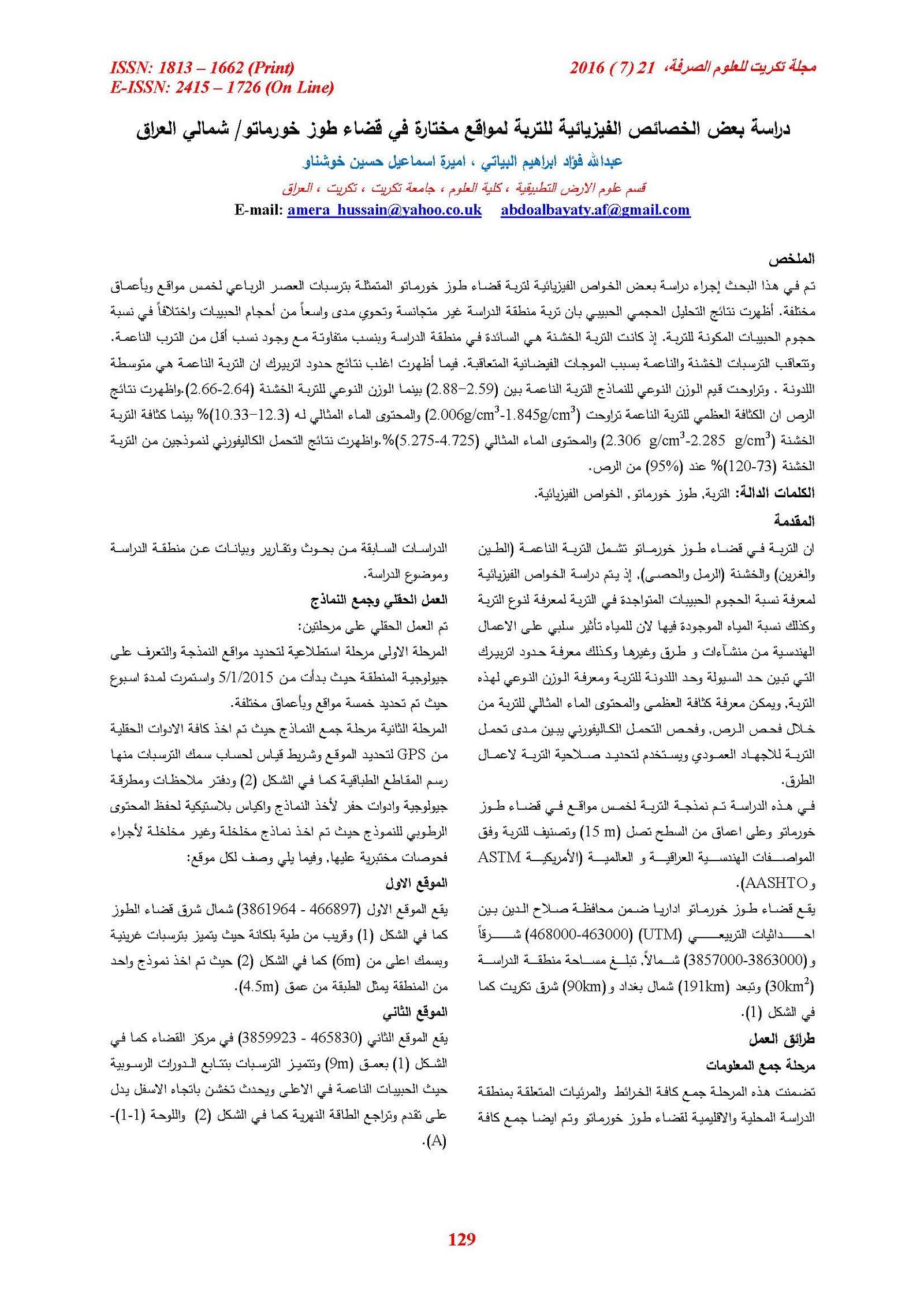Study Some Physical Properties For Soil In Tuz khormatu North Of Iraq
Main Article Content
Abstract
In this research, a study of some physical properties for the soil of tuz khormatu have been achieved of evaluating these properties represented by physical properties for five locations with different depths. The results of Particle size analysis have showed that the soil of study area is not homogeneous and it contains a wide range of particle sizes and difference in particle sizes ratio that form the soil. The coarse soil is dominating in the study area with varying ratios with less ratios of fine soils. The coarse and fine sedimentations comes successively because of the successive flood waves. whereas most results of Atterburg limits showed that the fine soil has moderately plastic. and The specific gravity values for fine soil has ranged between (2.59-2.88) whereas The specific gravity for coarse soil (2.64-2.66).and the compaction results have showed that the maximum dry density for fine soil has ranged (1.845-2.006)g/cm3 and the optimum moisture content (10.33-12.3)% while the maximum dry density of coarse soil is (2.285-2.306) g/cm3 and the optimum moisture content (4.725-5.275)%. And the results of (C.B.R) for two samples of coarse soil (73-120)% at (95%)of compaction
Article Details

This work is licensed under a Creative Commons Attribution 4.0 International License.
Tikrit Journal of Pure Science is licensed under the Creative Commons Attribution 4.0 International License, which allows users to copy, create extracts, abstracts, and new works from the article, alter and revise the article, and make commercial use of the article (including reuse and/or resale of the article by commercial entities), provided the user gives appropriate credit (with a link to the formal publication through the relevant DOI), provides a link to the license, indicates if changes were made, and the licensor is not represented as endorsing the use made of the work. The authors hold the copyright for their published work on the Tikrit J. Pure Sci. website, while Tikrit J. Pure Sci. is responsible for appreciate citation of their work, which is released under CC-BY-4.0, enabling the unrestricted use, distribution, and reproduction of an article in any medium, provided that the original work is properly cited.
References
[1] ASTM D2216, 2010, Standard Test Methods for Laboratory Determination of Water (Moisture) Content of Soil and Rock by Mass1.
[2] ASTM C127, 2015, Standard Test Method for Relative Density (Specific Gravity) and Absorption of Coarse Aggregate1, American Society for Testing Materials, West Conshohocken, Pennsylvania.
[3] ASTM C128, 2015, Standard Test Method for Relative Density (Specific Gravity) and Absorption of Fine Aggregate1, American Society for Testing Materials, West Conshohocken, Pennsylvania.
[4] ASTM D854 ,2014, Standard Test Methods for Specific Gravity of Soil Solids by Water Pycnometer1, American Society for Testing Materials, West Conshohocken, Pennsylvania.
[5] ASTM D422 − 63 (Reapproved 2007)ᵋ2, Standard Test Method for Particle-Size Analysis of Soils1, American Society for Testing Materials, West Conshohocken, Pennsylvania.
[6] ASTM D4318, 2014, Standard Test Methods for Liquid Limit, Plastic Limit, and Plasticity Index of Soils1.
[7] AASHTO T180, 2010: Standard Specification for Moisture-Density Relations of Soils Using a 4.54kg (10lb) Rammer and a 457mm (18in) Drop.
[8] ASTM D1883,2005 "Standard Test Method for Determination California Bearing Ratio for Aggregate".
[10] Kerbs, R. D., and Walker, R.D., 1971, High Way Material, 1st., McGraw-Hill Book Inc. USA,
428p.
[11] Mitchell, J., 1993, Fundamentals of soil Behavair, 2nd ed, John wiley and Sons inc. New York, 437 p.
[14] ASTM D2487.2006: Standard Practice for Classification of Soils for Engineering Purposes (Unified Soil Classification System)1.
